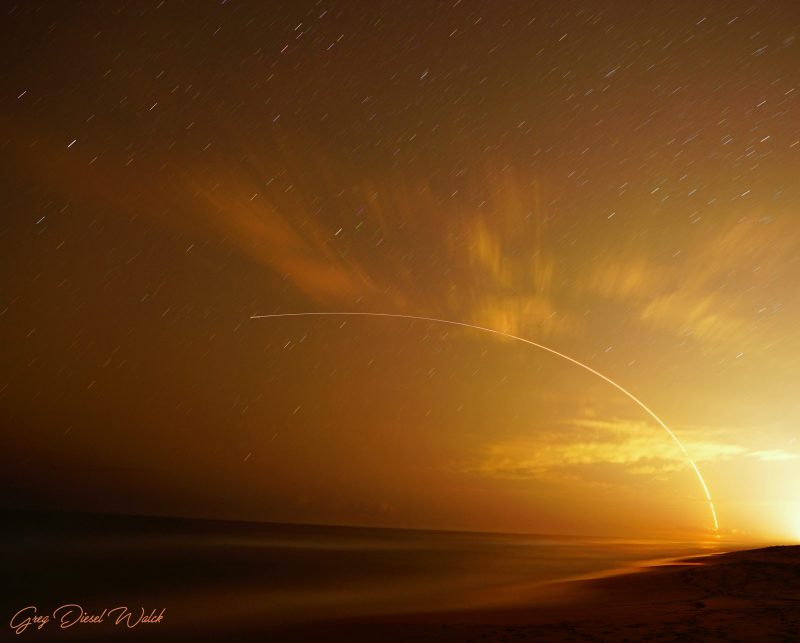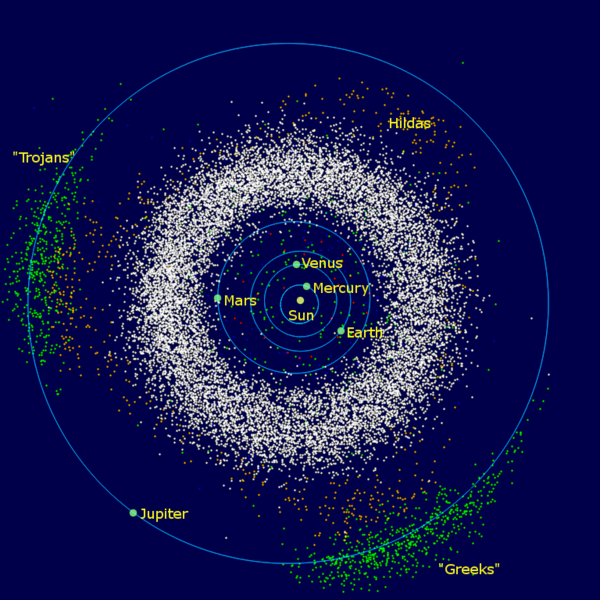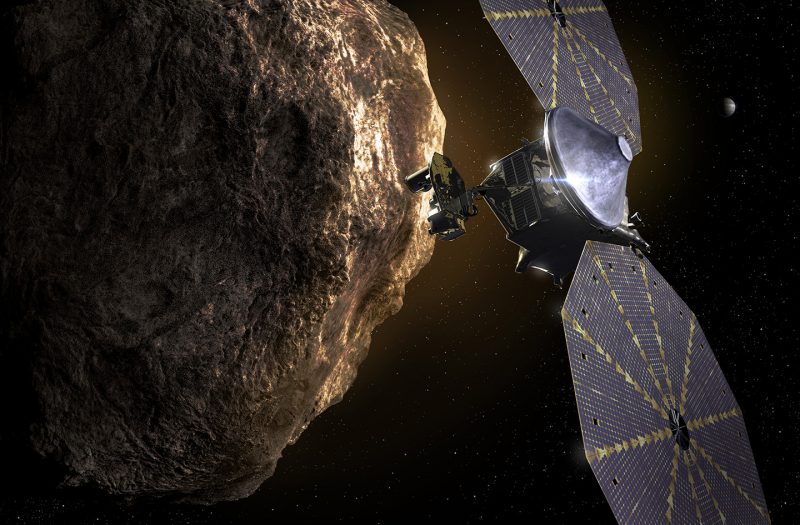Science matters. Wonder matters. You matter. Join our 2025 Donation Campaign today.
NASA has released the first images from the Lucy spacecraft’s encounter with asteroid Donaldjohanson. The encounter took place on April 20, 2025, in the main asteroid belt. The craft found the asteroid in a unique double-lobed shape, which, NASA said, likely formed a mere 150 million years ago. The spacecraft has now begun returning images that were collected as the craft flew approximately 660 miles (1,100 km) from Donaldjohanson on April 20. NASA said in a statement on April 21:
The asteroid was previously observed to have large brightness variations over a 10-day period, so some of Lucy team members’ expectations were confirmed when the first images showed what appeared to be an elongated contact binary (an object formed when two smaller bodies collide). However, the team was surprised by the odd shape of the narrow neck connecting the two lobes, which looks like two nested ice cream cones.
Hal Levison, principal investigator for Lucy at Southwest Research Institute, Boulder, Colorado, added:
Asteroid Donaldjohanson has strikingly complicated geology. As we study the complex structures in detail, they will reveal important information about the building blocks and collisional processes that formed the planets in our solar system.

Lucy flyby of asteroid Donaldjohanson
NASA said on April 21:
From a preliminary analysis of the first available images collected by the spacecraft’s L’LORRI imager, the asteroid appears to be larger than originally estimated, about 5 miles (8 km) long and 2 miles (3.2 km) wide at the widest point. In this first set of high-resolution images returned from the spacecraft, the full asteroid is not visible as the asteroid is larger than the imager’s field of view. It will take up to a week for the team to downlink the remainder of the encounter data from the spacecraft; this dataset will give a more complete picture of the asteroid’s overall shape.
Like Lucy’s first asteroid flyby target, Dinkinesh, Donaldjohanson is not a primary science target of the Lucy mission. As planned, the Dinkinesh flyby was a system’s test for the mission, while this encounter was a full dress rehearsal, in which the team conducted a series of dense observations to maximize data collection. Data collected by Lucy’s other scientific instruments, the L’Ralph color imager and infrared spectrometer and the L’TES thermal infrared spectrometer, will be retrieved and analyzed over the next few weeks.
The Lucy spacecraft will spend most of the remainder of 2025 travelling through the main asteroid belt. Lucy will encounter the mission’s first main target, the Jupiter Trojan asteroid Eurybates, in August 2027.
Named for an early human ancestor
The Lucy spacecraft is named for a famous fossilized skeleton found in Africa in 1974. On Sunday, it flew past asteroid Donaldjohanson, named for the paleoanthropologist best known for discovering the Lucy fossil.
Overall, Lucy is on a 4-billion-mile (6-billion-km) journey to explore a couple of main-belt asteroids and seven of Jupiter’s Trojan asteroids.
Zeroing in on Donaldjohanson
Back on February 25, 2025, NASA shared Lucy’s first views of Donaldjohanson. In the images, we can see the asteroid change its position between February 20 and 22.
This flyby is a test run for its encounter with Jupiter’s Trojan asteroids in 2027. Lucy already passed and imaged another main-belt asteroid – Dinkinesh – in November 2023. During that pass, images revealed it has a contact-binary moon, Selam. Who knows what the new images of Donaldjohanson will reveal?

Earth gave the Lucy spacecraft a boost
Lucy launched from Cape Canaveral, Florida, on October 16, 2021. Exactly one year later, the spacecraft swung past Earth for a gravity assist on Sunday, October 16, 2022. During the 2022 gravity assist, Lucy swept within 219 miles (352 km) of Earth’s surface. In fact, Lucy came so close to Earth that some lucky observers were able to watch the spacecraft soar overhead.
It was the first of three gravity assists from Earth, as the spacecraft wends its way outward through the solar system on its 12-year journey.
Why visit the Trojan asteroids?
The Trojans move in Jupiter’s orbit around the sun. Scientists view them as fossils left over from the formation of the solar system. And they’ve never been explored before.
Our fossilized ancestor called Lucy dates to some 3.2 million years ago. The skeleton of the fossil Lucy provided unique insight into human evolution. Likewise, the Lucy space mission will hopefully provide insight into our solar system’s evolution. Astronomer Hal Levison of the Southwest Research Institute (SwRI) in Boulder, Colorado, leads the Lucy mission. He spoke about Lucy’s journey to Jupiter’s Trojans and about how the mission got its name:
The Trojan asteroids are leftovers from the early days of our solar system, effectively fossils of the planet formation process. They hold vital clues to deciphering the history of our solar system. The Lucy spacecraft, like the human ancestor fossil for which it is named, will revolutionize the understanding of our origins.
Meanwhile, the asteroid Donaldjohanson is named for anthropologist Donald Johanson. He discovered the fossilized skeleton of Lucy in Africa.
The Lucy spacecraft’s long journey
Ultimately, Lucy’s 4-billion-mile (6-billion-km) journey will take it out to the orbit of Jupiter and the realm of Trojan asteroids, then back in toward Earth for gravity assists three times. Notably, this will be the first time a spacecraft returns to Earth’s vicinity from the outer solar system.
To answer some questions: the Lucy spacecraft is going out to several asteroids that share a very stable orbit around the Sun with the planet Jupiter. These asteroids are not coming to Earth! Follow @AsteroidWatch
for more about how we track asteroids near Earth.— NASA Solar System (@NASASolarSystem) October 16, 2021

The Lucy spacecraft target: Trojan asteroids
In fact, Trojan asteroids are a unique group of rocky bodies. Left over from the formation of the solar system, they orbit the sun on either side of Jupiter. Until now, no spacecraft has previously explored this collection of solar system fossils. Jupiter’s gravity, in effect, traps these asteroids in two swarms in its orbit, with some ahead of the planet and some trailing behind.
Given these points, Cathy Olkin, deputy principal investigator, said:
Lucy’s ability to fly by so many targets means that we will not only get the first up-close look at this unexplored population, but we will also be able to study why these asteroids appear so different. The mission will provide an unparalleled glimpse into the formation of our solar system, helping us understand the evolution of the planetary system as a whole.

Bottom line: The Lucy spacecraft is heading to Jupiter’s Trojan asteroids. But now it made its second asteroid encounter, with the main-belt asteroid Donaldjohanson, on April 20.
Read more about the Lucy mission
Human ancestor Lucy a tree climber